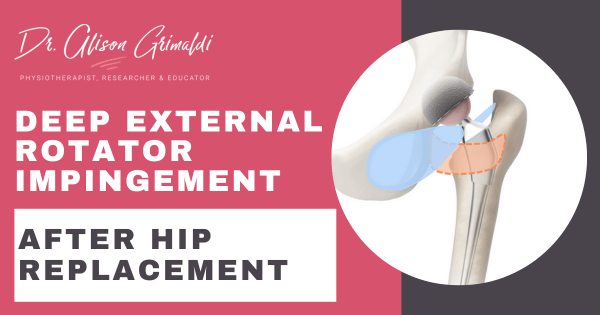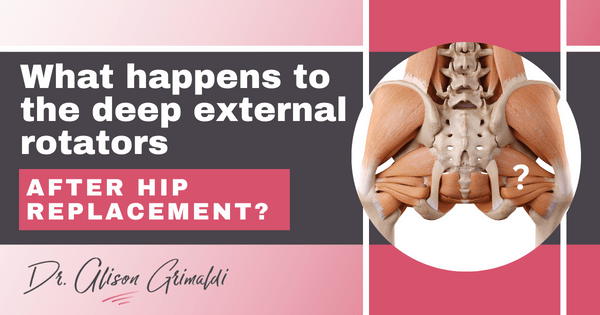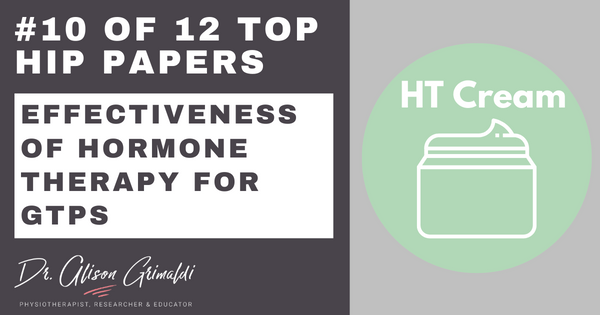Identifying joint hypermobility syndromes and measuring the impact

Joint hypermobility, characterised by an excessive range of motion in the joints, poses unique challenges for both patients and healthcare providers when symptoms arise. For many, excess mobility may never be a problem, and may in fact be an advantage in many athletic or performance pursuits. For others, joint hypermobility is just one aspect of a much more complex heritable disorder of the connective tissues, affecting multiple body systems with sometimes severe or even life-threatening impacts.
The impact and experience of such connective tissue disorders is very individual and variable, so health professionals need to be aware of the multifaceted nature of these conditions and have tools to assist in detecting them. This blog will aim to provide you with this information and the key tools required for use in clinical practice. Return to my blog page next month, where we’ll then focus our attention on hypermobility and the hip.
FREE RESOURCE!
Download My FREE Handout to Explore:
- Understanding joint hypermobility and the relationship with Heritable Connective Tissues Disorders & Hypermobility Spectrum Disorders
- The Beighton Score for Generalised Joint Hypermobility
- Lower Limb Assessment Score for Hypermobility
- Hakim & Grahame 5-point Questionnaire for Historical Joint Hypermobility
- Diagnostic Criteria for hypermobile Ehlers- Danlos Syndrome
Topics covered in this blog include:
- Terminology
- Joint Hypermobility
- Heritable Connective Tissue Disorders
- hEDS and Hypermobility Spectrum Disorders
- Prevalence of hypermobility
- Diagnosing hEDS and Hypermobility Spectrum Disorders
- The wider impact of hypermobility
Terminology - Joint Hypermobility, Heritable Connective Tissue Disorders, hEDS and Hypermobility Spectrum Disorders
Joint Hypermobility
Joint hypermobility sits at one end of the normal joint mobility spectrum, with hypomobility – reduced joint range-of-motion at the other.
The term ‘joint hypermobility’ refers to situations where a joint is able to move beyond normal physiological limits. These limits are usually imposed by bone and surrounding soft tissues (capsule, ligaments, muscle), and are influenced by non-modifiable factors such as age, sex and ethnicity.
Joint hypermobility may be congenital (usually related to a genes) or acquired (usually related to injury or surgery, or hormones e.g., pregnancy), and it can be global or focal.
There are 4 categories of joint hypermobility, including:
- Generalised joint hypermobility,
- Peripheral joint hypermobility,
- Localised joint hypermobility, and
- Historical joint hypermobility
Generalised joint hypermobility
Generalised joint hypermobility, as the name suggests, is a more generalised form of hypermobility. It affects both the spine and peripheral joints. Patients with GJH often refer to themselves as being ‘double jointed’.
Peripheral joint hypermobility
Peripheral joint hypermobility affects the extremities (i.e. hands and feet joints) only. It is usually present on both sides and is common in children.
Localised joint hypermobility
Localised joint hypermobility affects 1-2 joints or groups of joints (e.g., lumbar spine, hand, foot). This is most commonly associated with injury or repetitive or prolonged overload of the joint towards the end of its physiological range.
Historical joint hypermobility
This is self-reported by the patient. Physical testing may be negative, but the patient reports a history of excessive joint range-of-motion and/or instability.
"It is important to be mindful that Joint Hypermobility is NOT a diagnosis but characterises where an individual sits within the normal distribution of joint mobility. Many people have joint hypermobility without any additional symptoms."
Where generalised joint hypermobility is associated with symptoms, Heritable Connective Tissue Disorders such as Marfan Syndrome, Ehlers Danlos Syndrome, or other Hypermobility Spectrum Disorders should be considered. Exploring such diagnoses is important, as genetic malfunction may also be manifesting in less visible systems e.g., impact on the cardiovascular, autonomic, gastro-intestinal and urogenital systems.

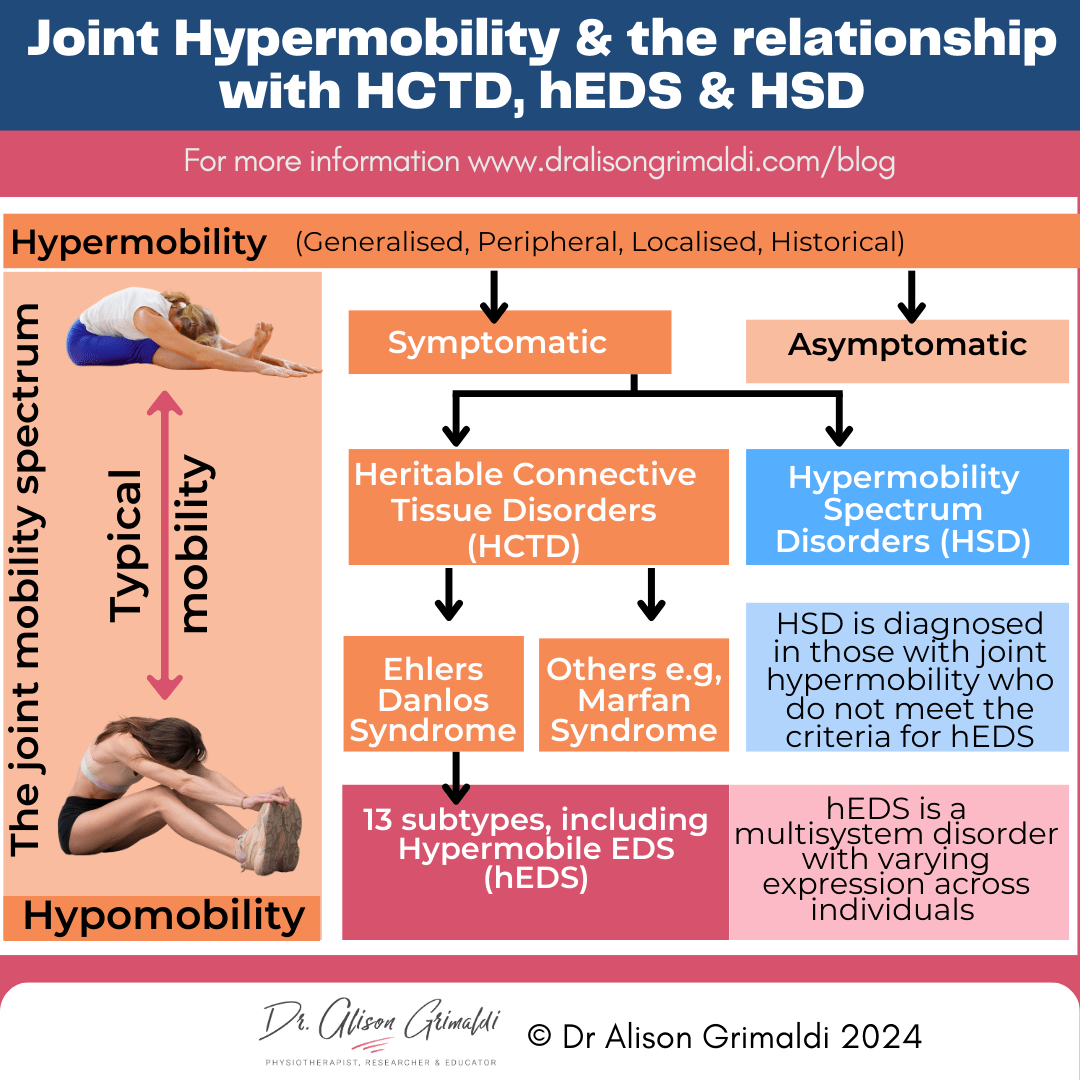
Heritable Connective Tissue Disorders
Heritable Connective Tissue Disorders (HCTDs) are conditions related to mutations in a wide range of genes involved in encoding for structure and function of connective tissue. As connective tissue is integral to bodily structure and function, the manifestations of such mutations can be wide, varied and sometimes life-threatening.
Three of the most common heritable connective tissue disorders are Marfan Syndrome, Ehlers Danlos Syndrome and Loeys-Dietz Syndrome. There is clinical overlap in these conditions – for example those with Marfan Syndrome usually have joint hypermobility, but the primary characteristics are cardiovascular, ocular, and skeletal manifestations, with Marfan syndrome often initially recognised due to long fingers and wide arm span.
Ehlers Danlos Syndrome and Hypermobile Ehlers Danlos Syndrome
The Ehlers–Danlos Syndromes (EDS) are a group of heritable connective tissue disorders characterized by joint hypermobility, skin hyperextensibility, and tissue fragility.1 The classification of these disorders was updated in 2017, at which time there were 13 recognised EDS subtypes. Genetic markers have been established for all but one EDS subtype - hypermobile EDS, or Ehlers Danlos Syndrome – Hypermobility Type.
As there are no genetic tests for Hypermobile EDS (hEDS). The diagnosis of this subtype is made on clinical assessment findings – find details further down the page.
Hypermobility Spectrum Disorder (HSD):
Those with symptomatic generalised joint hypermobility who do not meet the criteria for hypermobile Ehlers Danlos Syndrome, or any other heritable connective tissue disorder, are then diagnosed with a Hypermobility Spectrum Disorder.
Prevalence of hypermobility
Generalised joint hypermobility is common in the general population, present in 6-57% of females and 2-35% of males, with higher rates in those with Asian, Inuit or African ethnicity.2 Micale et al 2021
Around 10% of those with generalised joint hypermobility have accompanying physical and/or psychological symptoms,3 and are therefore eligible for assessment for a diagnosis of a Heritable Connective Tissue Disorder like hypermobile EDS (hEDS), or a Hypermobility Spectrum Disorder.
Heritable connective tissue disorders have historically been considered rare, with an anecdotal figure of 1: 5000 often quoted. However, recent research has shown that the hypermobile form of EDS and other Hypermobility Spectrum Disorders are likely to be much more prevalent than previously thought.
A large study in Wales reported the prevalence of hEDS and Hypermobility Spectrum Disorders to be around 1 in every 500 people (much more common than 1 in 5000!).4
And most importantly for physios and other rehab professionals reading this blog, those with hEDS and Hypermobility Spectrum Disorders may represent 30-40% of the population coming to see you for pain or musculoskeletal conditions.5,6 Even higher figures (55%) have been reported if only females are considered.7
Are you looking out for people with these conditions?
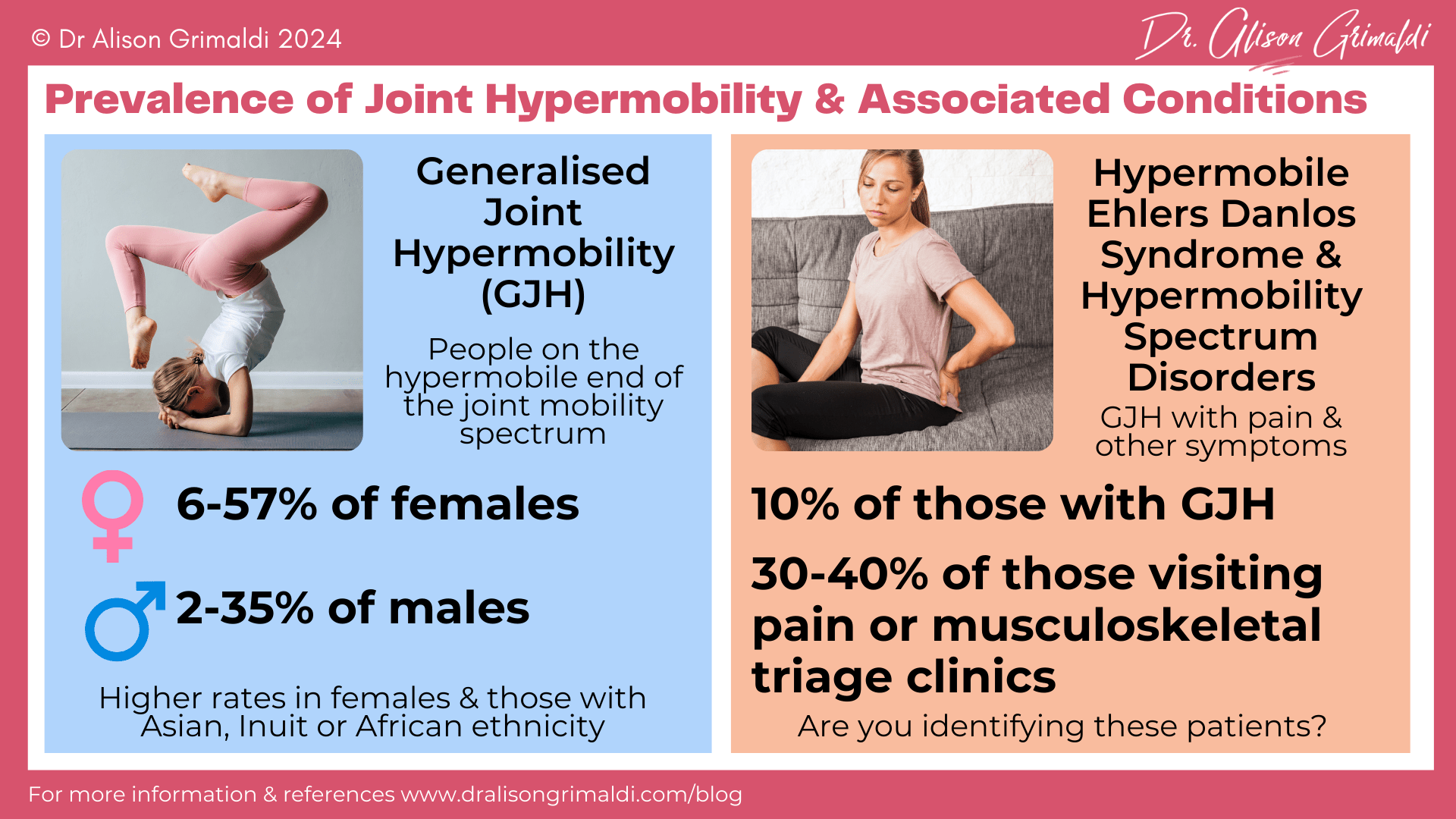
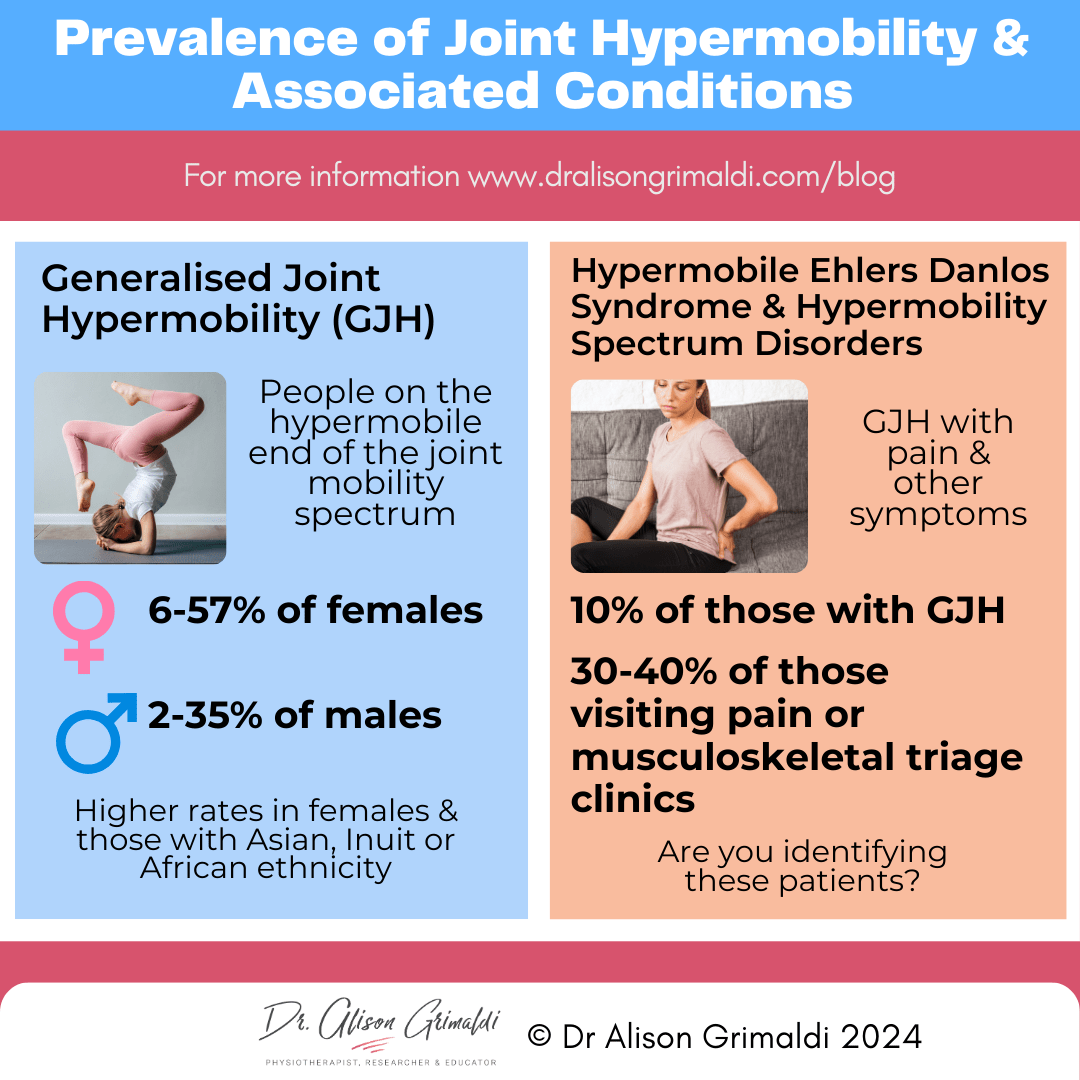
Diagnosing hEDS and Hypermobility Spectrum Disorder
Now you are looking out for these conditions, how will you recognise them and formally diagnose hypermobile Ehlers Danlos Syndrome or Hypermobility Spectrum Disorder?
Identifying joint hypermobility
The first step is usually identifying generalised joint hypermobility. Traditionally, the Beighton score has been used as a quick clinical indicator of joint hypermobility but appropriate sex and age specific cut-offs should be used. Additional scoring systems can be used to provide a more detailed assessment of lower limb and upper limb mobility. Historical joint hypermobility can be assessed with the Hakim and Grahame 5-point Questionnaire (read on to find this questionnaire).
Beighton Score of Generalised Joint Hypermobility
The Beighton Score is a simple clinical screening tool for joint hypermobility, involving the assessment of 9 joints or regions.8 For each of the 9 clinical tests performed, 1 point is assigned if the criterion for excess mobility is reached, and 0 is assigned for normal mobility.
One point is scored when each criterion is reached for the 9 items in the Beighton Score:
- Palms can rest flat on the floor during forward flexion of the trunk, standing with the knees extended,
- Hyperextension of the knees beyond 10° (one point for each knee),
- Hyperextension of the elbows beyond 10° (one point for each elbow),
- The thumb can be passively touched against the flexor aspect of the forearm (one point for each hand), and
- The 5th finger can be extended beyond 90degrees at the metacarpophalangeal joint (one point for each hand).


Interpreting the score is the next important step. Traditionally a score cut-off ≥4 has been used to identify individuals with generalised joint hypermobility using the Beighton scale.
However, more recent research has demonstrated that a Beighton score cut-off of ≥4 for generalised joint hypermobility has a 60% false positive rate!8
"A Beighton score cut-off of ≥4 for generalised joint hypermobility has a 60% false positive rate!"
The primary reasons for this high false positive rate, are the normal presence of greater mobility in females and children. Singh and colleagues (2017) recommended that age- and sex-specific cut-off scores should be utilized for generalised joint hypermobility (see the image below).8

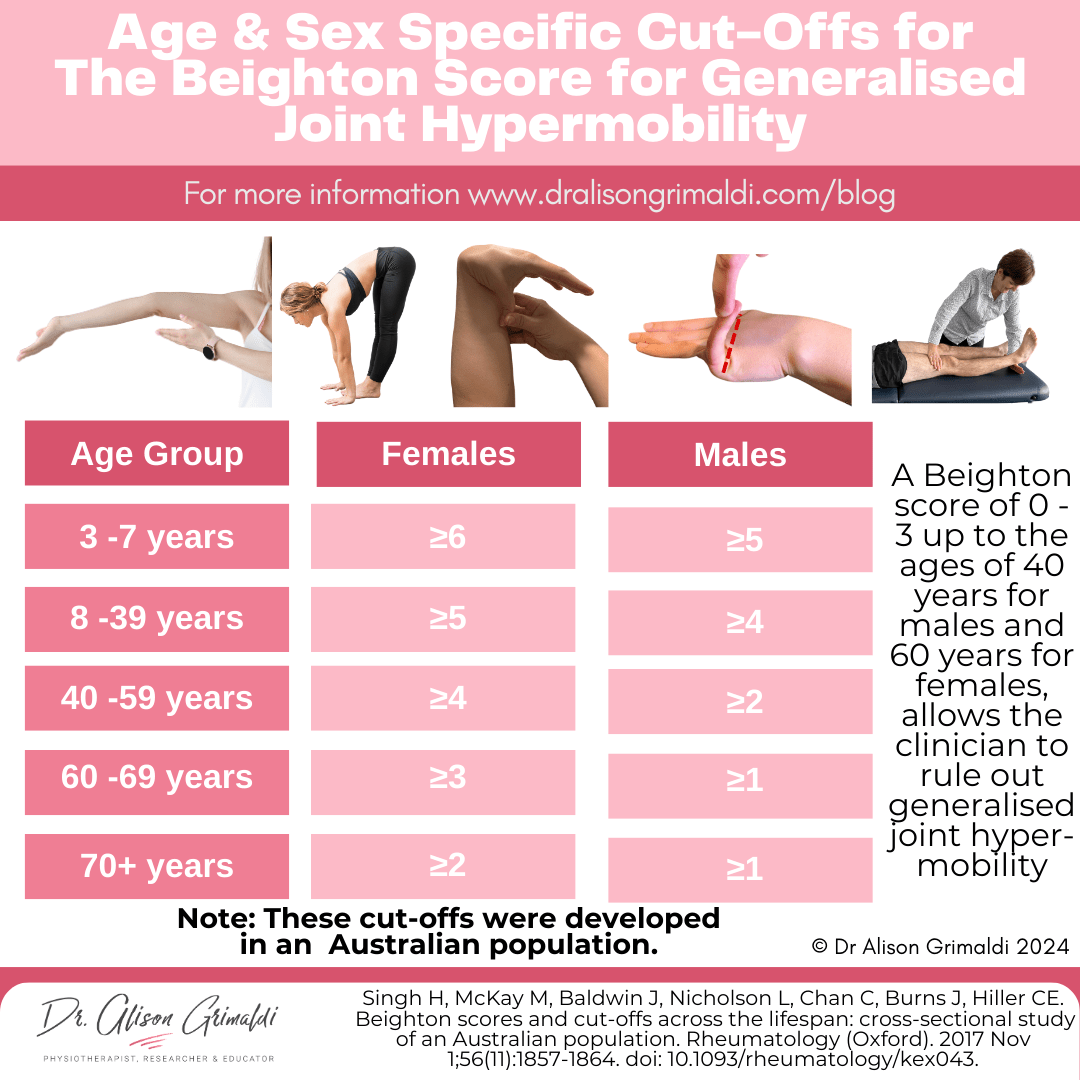
"A Beighton score of 0 - 3 up to the ages of 40 years for males and 60 years for females, allows the clinician to rule out generalised joint hypermobility."
The other drawback with the Beighton Score is the sampling that is used. There are no assessments of the hip, shoulder or foot, which are also quite commonly affected. This has prompted development of lower limb and upper limb specific hypermobility assessment tools, to better assess joint hypermobility in the peripheral joints.
Lower Limb Assessment Score for Joint Hypermobility
As our focus for this blog is lower limb hypermobility, we’ll restrict the conversation to the Lower Limb Assessment Score for Joint Hypermobility,9 but you may also like to look up the Upper Limb Hypermobility Assessment Tool.10
The Lower Limb Assessment Score is a validated tool for identifying lower limb specific hypermobility. The assessment involves both physiological and accessory movements, with 12 possible points for each lower limb. One point is assigned if the criterion for excess mobility is reached, and 0 is assigned for normal mobility.
The 12 point Lower Limb Assessment Score for hypermobility includes the following criteria:
- Excessive passive hip flexion
- Excessive hip abduction (abduction – external rotation)
- More than normal knee hyperextension
- Laxity identified in an anterior draw test of the knee
- Excessive tibiofemoral rotation
- More than 15° of ankle dorsiflexion
- Laxity identified in an anterior draw test of the ankle
- ≥ 45° of subtalar joint inversion
- ≥ 45° of midtarsal joint inversion
- Laxity identified on midtarsal joint ab/adduction and dorsi /plantarflexion
- >90° of 1st metatarso-phalangeal joint extension
- Excessive subtalar joint pronation in weightbearing

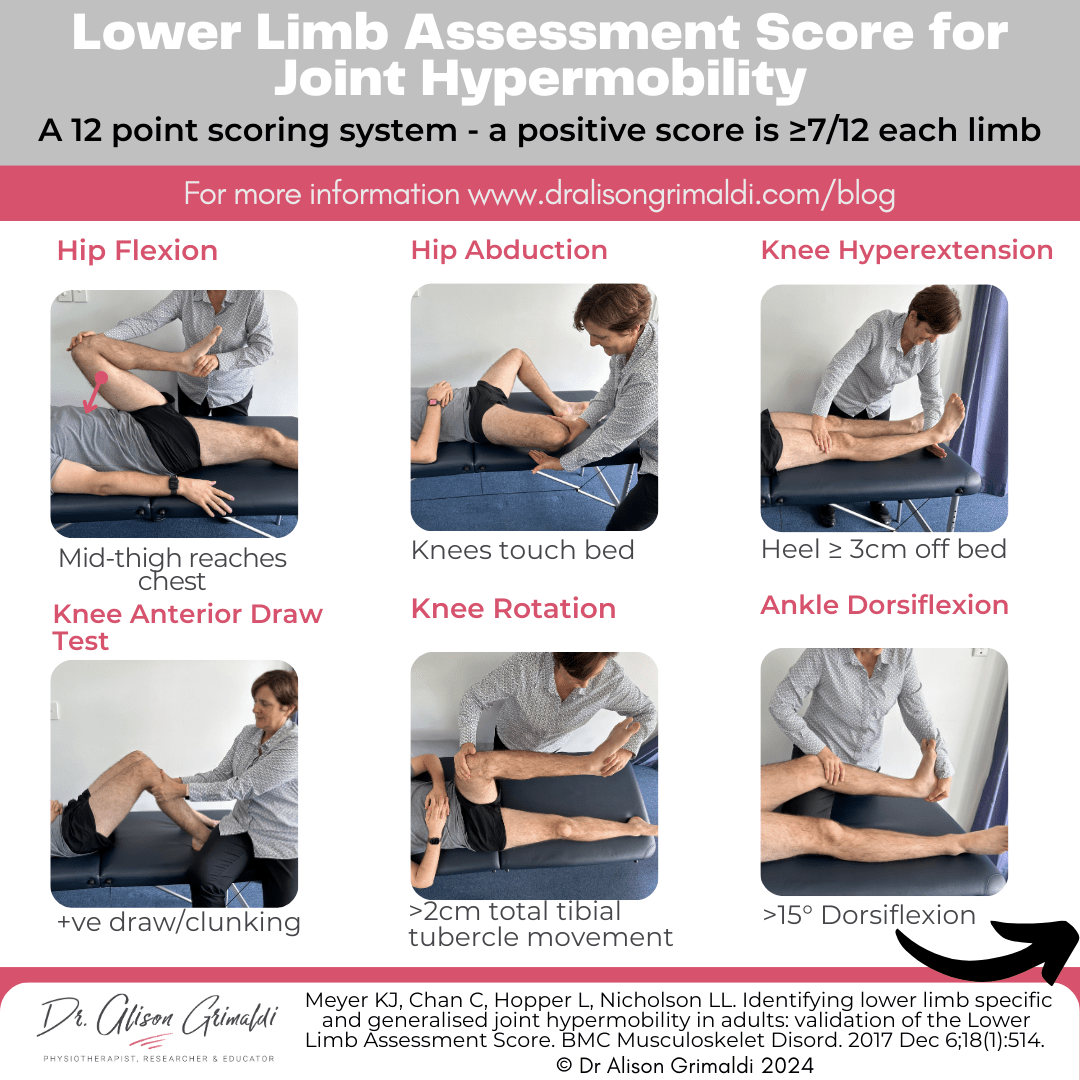
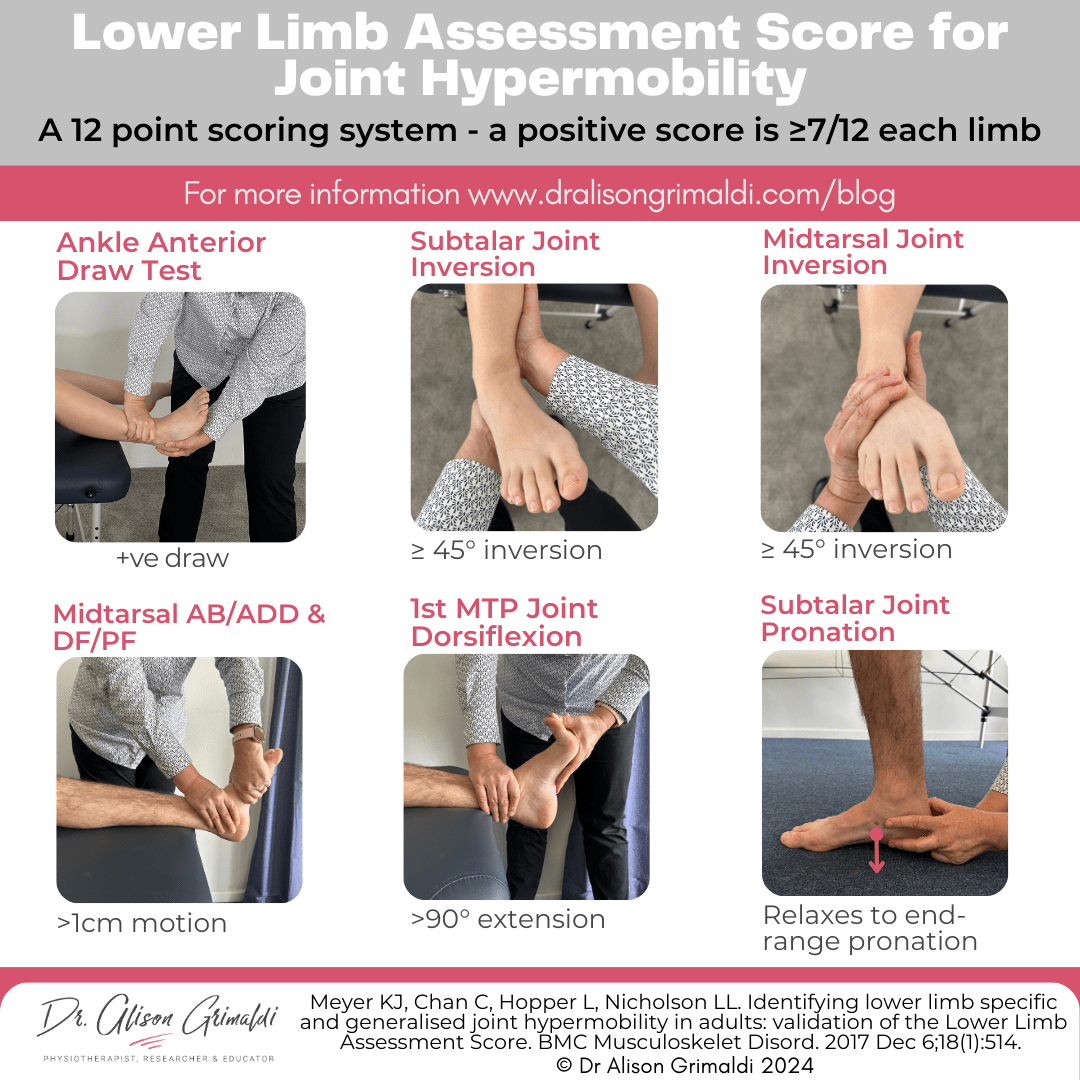
When a threshold of 7/12 points is achieved or surpassed for a limb, the identification of lower limb hypermobility can be made with a specificity of 86% and sensitivity of 68%.11 Note that the population used for validation was predominantly Caucasian.
The Lower Limb Assessment Score can be useful for identifying peripheral and localised joint hypermobility of the lower limbs. For further details around assessment and the criteria, you can download our free guide on clinical assessment of joint hypermobility, hypermobile Ehlers Danlos Syndrome and Hypermobility Spectrum Disorders.
Hakim & Grahame 5-point Questionnaire for Historical Joint Hypermobility
Hakim and Grahame (2003) developed a 5-point questionnaire for identifying individuals with joint hypermobility.12 This can be useful for understanding someone’s natural positioning along the joint mobility spectrum, even though they may no longer reach the threshold for a positive Beighton score.
We also use this 5-point Questionnaire for hypermobility in our new patient intake surveys. This can be useful as an initial screening tool, highlighting for the clinician that they may need to explore this further in the patient interview and perform further clinical assessment for joint hypermobility.
The 5 questions for historical joint hypermobility are:
- Can you now (or could you ever) place your hands flat on the floor without bending your knees?
- Can you now (or could you ever) bend your thumb to touch your forearm?
- As a child, did you amuse your friends by contorting your body into strange shapes or could you do the splits?
- As a child or teenager did your shoulder or kneecap dislocate on more than one occasion?
- Do you consider yourself double-jointed?
Answering yes to 2 or more of these questions has been reported to differentiate between those with and without joint hypermobility with 85% accuracy.12


Diagnosing hypermobile Ehlers Danlos Syndrome (hEDS)
Having generalised joint hypermobility is not sufficient for a diagnosis of hypermobile EDS or other Hypermobility Spectrum Disorders. Presence of generalised joint hypermobility is required but fulfils only the first criteria of the 2017 guidelines for diagnosis of hEDS.1,2,13
There are 3 criteria and a diagnosis of hEDS is only possible if the individual meets ALL 3 criteria.
Let’s explore these criteria.
Criterion 1 for diagnosing hypermobile Ehlers Danlos Syndrome
Criterion 1 is reaching an appropriate threshold for generalised joint hypermobility.
To fulfil criterion 1, an individual must:
- reach an age and gender appropriate Beighton score
- ≥6 for pre-pubertal children and adolescents
- ≥5 for pubertal men and women up to the age of 50
- ≥4 for those >50 years of age
OR
- reach a Beighton Score 1 point below the age- and sex-specific cut-off AND at least 2 points on the 5-point questionnaire (for those with historical generalised joint hypermobility or acquired joint limitations).


Criterion 2 for diagnosing hypermobile Ehlers Danlos Syndrome
To fulfil criterion 2, an individual must demonstrate features in at least 2 of the following 3 categories:
Feature A: Systemic features of a generalized connective tissue disorder e.g., skin or fascia signs; pelvic floor concerns; Marfanoid features. At least 5 features must be present.
Feature B: A positive family history with one or more first degree relative meeting the diagnostic criteria for hypermobile Ehlers-Danlos syndrome.
Feature C: Musculoskeletal complications e.g., musculoskeletal pain in ≥ 2 locations for ≥3 months, widespread pain for ≥3 months, recurrent, atraumatic dislocations. At least one feature must be present.
In those with an acquired connective tissue disorder such as lupus or rheumatoid arthritis, a diagnosis of hypermobile Ehlers-Danlos syndrome requires meeting both features A and B of criterion 2.
FREE RESOURCE!
Download My FREE Handout to Review Full Details On Criterion 2 +
- Understanding joint hypermobility and the relationship with Heritable Connective Tissues Disorders & Hypermobility Spectrum Disorders
- The Beighton Score for Generalised Joint Hypermobility
- Lower Limb Assessment Score for Hypermobility
- Hakim & Grahame 5-point Questionnaire for Historical Joint Hypermobility
- Diagnostic Criteria for hypermobile Ehlers- Danlos Syndrome
Criterion 3 for diagnosing hypermobile Ehlers Danlos Syndrome
The final criterion for diagnosing hypermobile Ehlers Danlos Syndrome is an exclusion of other heritable and acquired connective tissue disorders e.g., other types of Ehlers Danlos Syndrome, Marfan Syndrome or rheumatological diseases such as lupus and rheumatoid arthritis. Exclusion of these other diagnoses may be based upon history, physical examination, and/or molecular genetic testing, as indicated.13
Diagnosing a Hypermobility Spectrum Disorder (HSD)
The diagnosis of a hypermobility spectrum disorder is used for those with symptomatic joint hypermobility, who do not meet the criteria for a diagnosis of hypermobile Ehlers Danlos Syndrome or other heritable or acquired (rheumatological or through injury) connective tissue disorders.
The primary features of hypermobility spectrum disorders are musculoskeletal, with more limited extension to other organs and tissues compared with hEDS.
Musculoskeletal manifestations of HSDs include:
- macro- or micro-instability,
- chronic musculoskeletal pain,
- disturbed proprioception (poor joint awareness) and muscle weakness,
- degenerative joint or bone disease, and
- other musculoskeletal traits such as pes planus foot type, scoliosis, kyphotic-lordotic spinal shape, valgus deformity of elbows, knees, hindfeet and halluces.13
As with joint hypermobility, hypermobility spectrum disorders can be subcategorised into:
- Generalised HSD (G-HSD): symptomatic generalised joint hypermobility
- Peripheral HSD (P-HSD): symptomatic peripheral joint hypermobility (hands/feet)
- Localised HSD (L-HSD): symptomatic localised joint hypermobility, and
- Historical HSD (H-HSD): Historical joint hypermobility with musculoskeletal symptoms.
In most of our community clinical practices, those with musculoskeletal pain in the context of joint hypermobility are likely to fall under the umbrella of hypermobility spectrum disorders, with hEDS relatively less common.
The Wider Impact of Hypermobility
There may be wider effects of hypermobility across a number of body systems, due to the widespread presence of connective tissues throughout the body. These multisystem effects are more limited in Hypermobility Spectrum Disorders but present with greater severity in hypermobile EDS.
The identification of these more severe, multisystem impacts assists in differentiating hEDS, as we discussed above, and highlighting where a multidisciplinary approach may be required.
Many patients with hypermobility will be unaware of the links between their symptoms across multiple systems, and they may not volunteer what seems like irrelevant information. Their physiotherapist or general practitioner may be the first to make the links.
It is important for first contact health practitioners to screen for these wider effects in those presenting with symptomatic joint hypermobility. These effects may go untreated or may be treated less effectively if the relationship between symptoms is not recognised.
The multisystem effects of hypermobile Ehlers Danlos Syndrome
The multisystem effects of hEDS include:14
- Musculoskeletal – joint pain and instability, tendinopathy, weakness, reduced bone density
- Neurological/Neurodevelopmental – proprioceptive, coordination, sensory deficits, neuralgia, Autistic Spectrum Disorder, Attention Deficit Hyperactivity Disorder
- Autonomic nervous system – cardiac dysautonomia, Postural Orthostatic Tachycardia Syndrome (POTS), Raynaud’s – cold hands and feet
- Dermatological – hyperextensible skin, easy bruising, poor healing, scarring
- Gastrointestinal – Gastric reflux, pain, slow transit, constipation, irritable bowel
- Cardiorespiratory – Mitral valve prolapse, aneurysms, varicose veins, asthma-like symptoms due to floppy airways
- Mental health - Anxiety, depression
- Uro-genital – Urinary incontinence, prolapses, painful periods
- Immunological – Mast cell activation syndrome, rashes and sensitivities
- Multisystemic – widespread pain, chronic fatigue and sleeping difficulties.


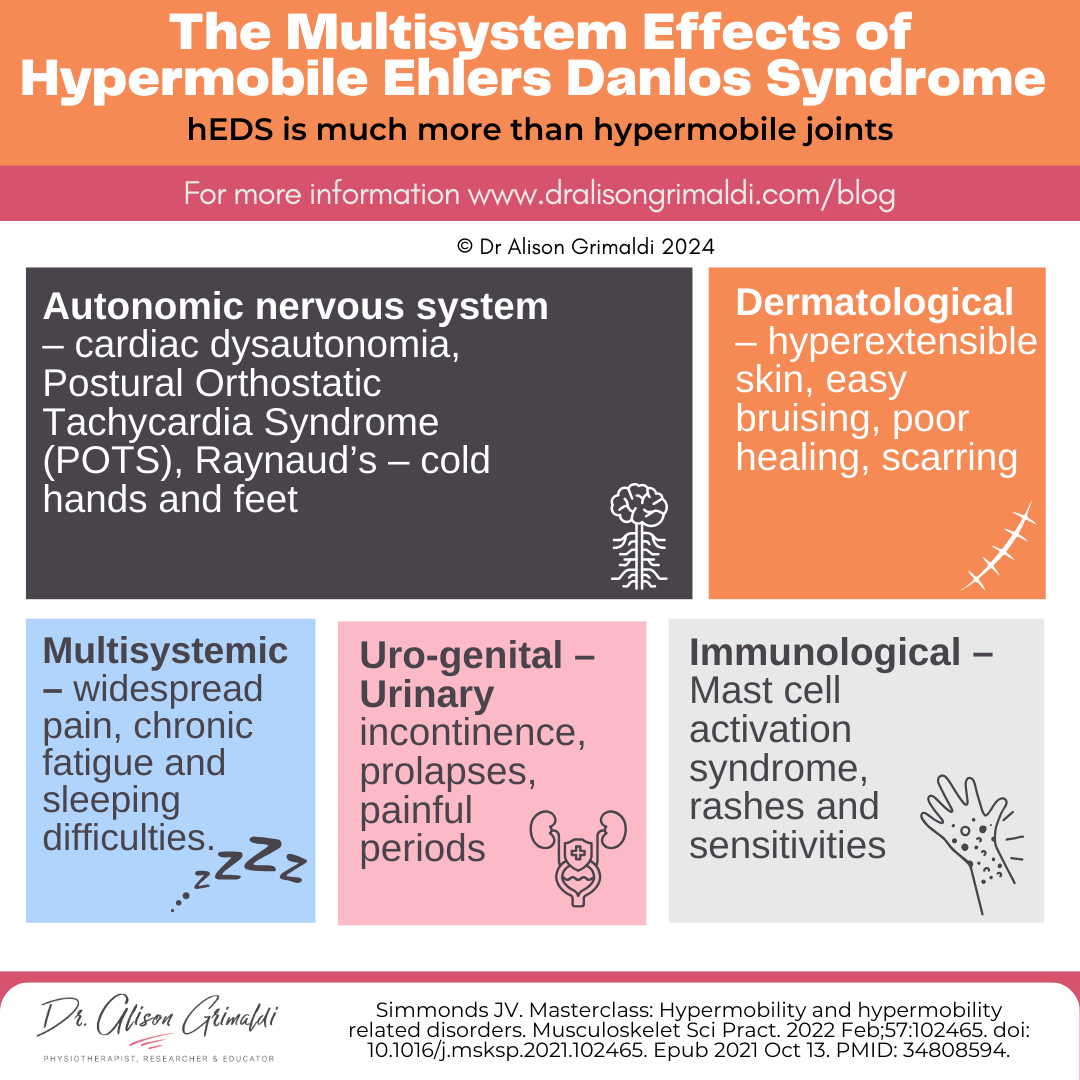
Measuring the Impact of Hypermobility – The Spider Questionnaire
Jane Simmonds, hypermobility expert, and colleagues have developed a helpful questionnaire that measures the multisystem impact of hypermobility – the Spider Questionnaire.15 This allows health professionals to understand the specific effect of hypermobility on each individual, and measure change in this effect in response to interventions. This questionnaire has been validated against other domain specific measures in both adolescents and adults – adult paper yet to be published.
This questionnaire asks people to rate the impact of their hypermobility on their daily life across 8 domains, using a 6-point Likert scale from no impact to disabling.
The following domains and constructs are included:
1. Neuromusculoskeletal: 5 questions
-
- Joint instability
- Muscle weakness
- Muscle spasms
- Balance and proprioception
- Sensation
2. Pain: 4 questions
-
- Joint pain
- Widespread pain
- Headaches or migraines
- Allodynia/ hyperalgesia
3. Fatigue: 3 questions
-
- Physical fatigue
- Mental fatigue
- Sleep disturbances
4. Gastrointestinal: 4 questions
-
- Abdominal pain/bloating
- Diarrhoea/ constipation
- Nausea/ vomiting
- Reflex, regurgitation, swallowing difficulties
5. Cardiac Dysautonomia: 4 questions
-
- Feeling faint moving with postural changes
- Situations which cause racing heart and feeling faint
6. Urogenital: 5 questions
-
- Urinary frequency
- Urine loss
- Urinary retention
- Genital discomfort
- Urinary tract infections
7. Anxiety: 3 questions
-
- Fear of movement
- Worry
- Feeling afraid
8. Depression: 3 questions
-
- Sadness
- No solutions to health problems
- Loss of interest
As its name suggests, the Spider Questionnaire for joint hypermobility also provides a pictorial representation of each individual’s multisystem impact, in the form of a spider’s web. Each domain is an arm of the spider’s web, and higher impact in particular domains skews the web, pointing out the priorities for further investigation or intervention.
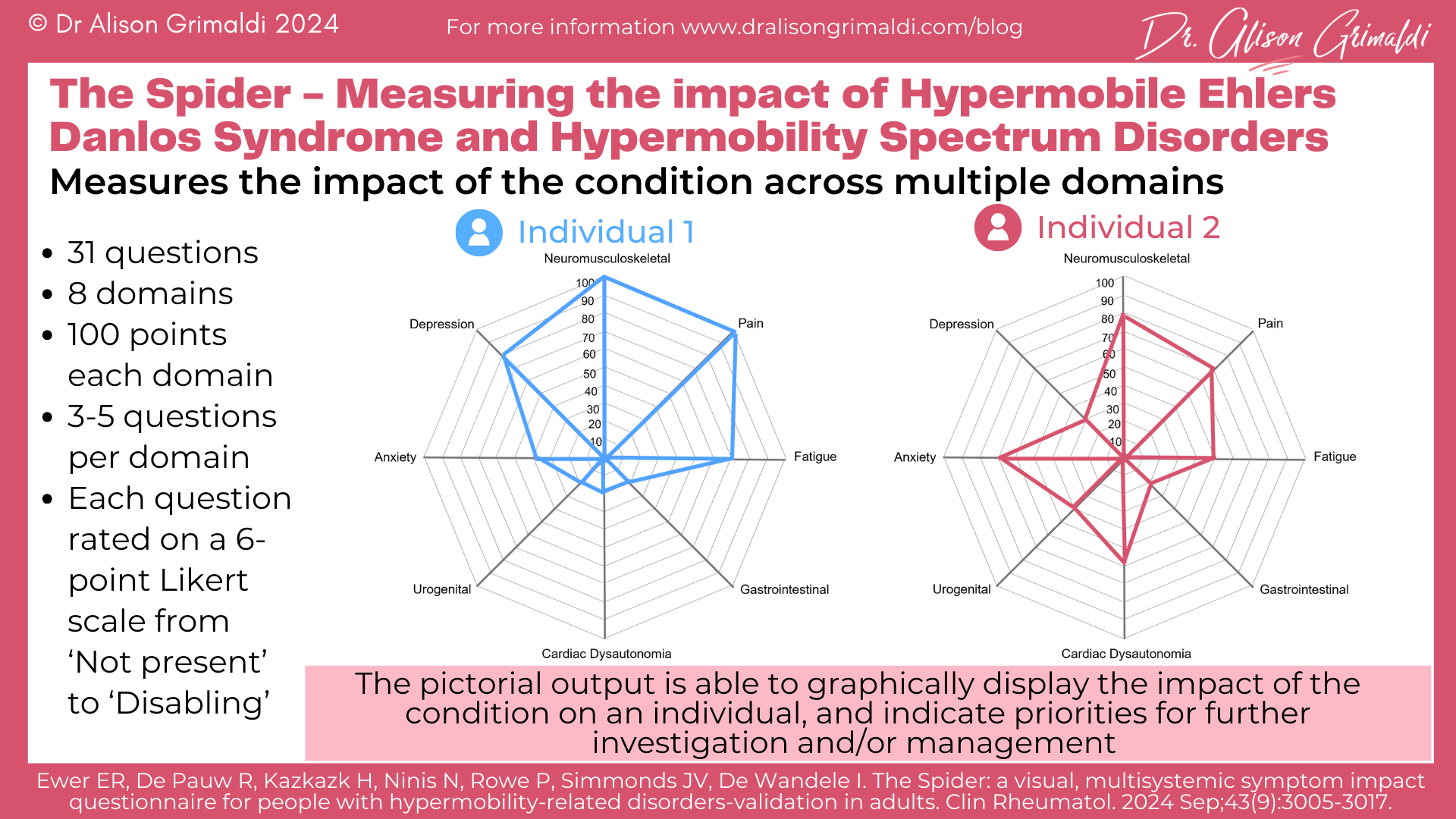
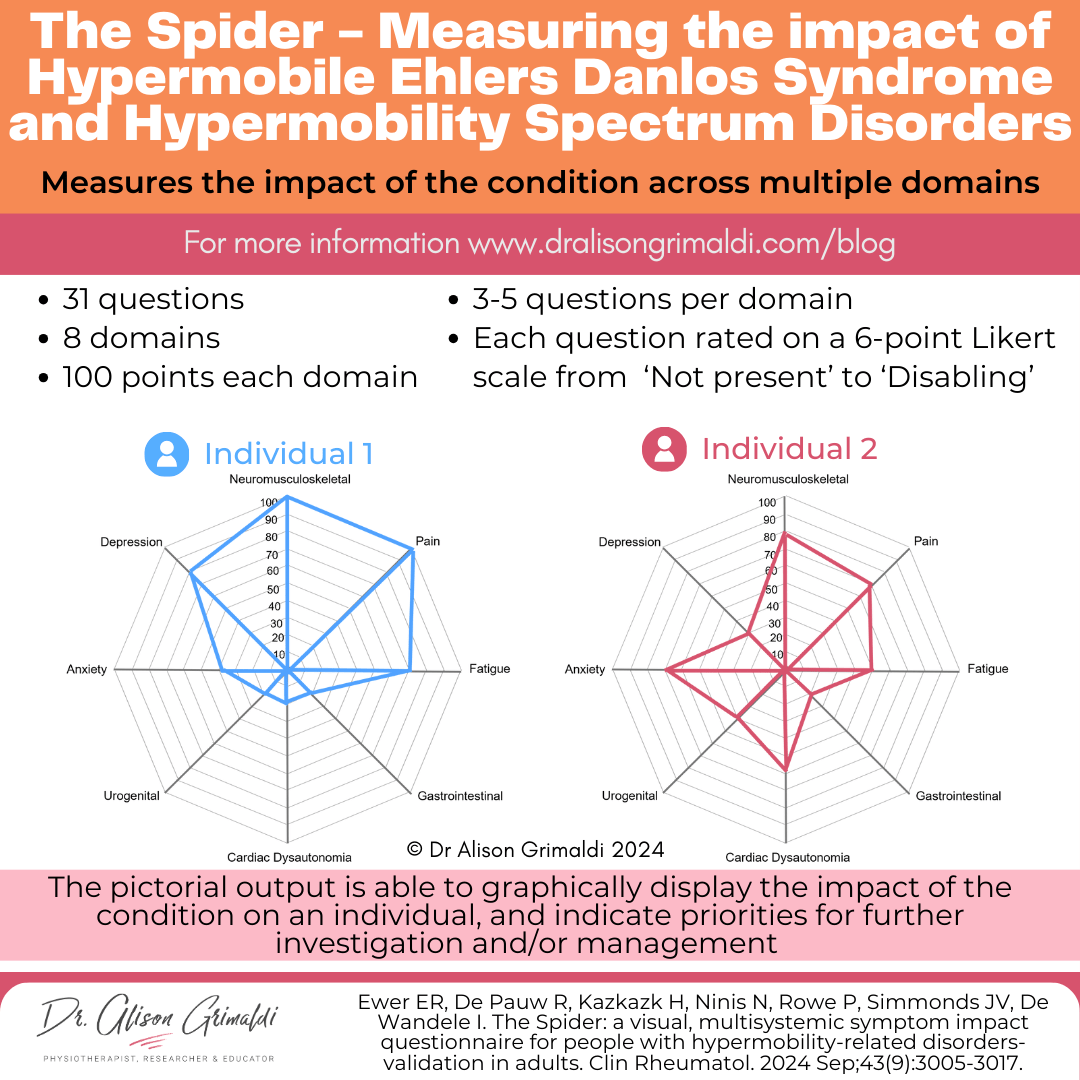
This can be very helpful for use in musculoskeletal healthcare environments.
For example,
- High impact (skewed spider’s web) in the anxiety and depression domains, may suggest some additional psychological support is likely warranted, but keep in mind that some of the anxiety may be related to tachycardia and fear of dislocations, and depression linked with the wide impact of the condition, so addressing other domains may also assist with mental health impact.
- High impact in the cardiac dysautonomia domain would suggest a cardiology review is warranted.
- High impact in the gastrointestinal domain may point toward the need for a review with a gastroenterologist and/or dietitian.
- High impact in the urogenital domain may indicate need for referral to other health professionals such as a pelvic health physiotherapist, urologist or gynaecologist, depending on the particular symptoms.
Implications for management of those with hypermobility in musculoskeletal healthcare
These multidomain effects are also important to factor into a musculoskeletal management plan.
Orthostatic intolerance will impact on the patient’s ability to adopt certain positions and move quickly between positions.
Advice around salt/electrolyte and fluid intake may be required, and compression garments/clothing can help – e.g., compression pants.
Fatigue is also a large consideration – consider time of day, start with less – pacing is critical, and allow more time for recovery and adaptation.
Alter your expectations for recovery – recovery from injury and surgery will often be delayed and outcomes may be poorer. Longer rehabilitation times are required. A multidisciplinary approach is more likely to be required. Analysis of Spider questionnaire results has shown that fatigue, cardiac dysautonomia, and depression are strongly associated with poorer functional ability in adolescents.
Education and a supportive environment are also key – these patients are often experiencing anxiety, depression, sleep deprivation and ‘foggy brain’. Allow time for learning and reassurance and develop your intervention within a shared decision-making model.
In the musculoskeletal domain, I usually take an ‘inside-out’ approach, aiming to optimise local stability around excessively mobile joints, and establish more ideal movement patterning, before adding load into the system. Often these patients may not do as well if they are pushed straight into a generic strengthening program. Expect greater difficulty in learning movement patterning, and longer periods to progress. Compression and tactile feedback can assist with proprioceptive awareness.
Have you heard about Hip Academy?
Learn more about Hypermobility and the Hip in Hip Academy:
September Meeting: Hypermobility & The Hip
This live (and recorded) Hip Academy meeting, will explore:
- Terminology & prevalence of hypermobility related conditions
- Diagnosing hEDS and Hypermobility Spectrum Disorders
- The Spider – a tool for measuring the multisystem impact of hEDS and HSD
- The relationship between hypermobility, hip conditions and treatment outcomes – this will cover links with acetabular dysplasia, femoral malversion, capsulo-labral deficiency, osteoarthritis, and the outcomes of hip arthroscopy and arthroplasty.

Enjoy the benefits of a world class educational Hip Program, specifically designed by Dr Alison Grimaldi to help improve your knowledge surrounding the Hip and Pelvis, and become an expert in your field + Get access to all previous member meeting recordings!

This blog was written by Dr Alison Grimaldi
Dr Alison Grimaldi is a physiotherapist, researcher and educator with over 30 years of clinical experience. She has completed a Bachelor of Physiotherapy, a Masters of Sports Physiotherapy and a PhD, with her doctorate topic in the hip region. Dr Grimaldi is Practice Principal of PhysioTec Physiotherapy in Brisbane and an Adjunct Senior Research Fellow at the University of Queensland. She runs a global Hip Academy and has presented over 100 workshops around the world.
Check Out Some More Relevant Blogs
References:
- Malfait F, Francomano C, Byers P, et al. The 2017 international classification of the Ehlers-Danlos syndromes. Am J Med Genet C Semin Med Genet. 2017 Mar;175(1):8-26. doi: 10.1002/ajmg.c.31552. PMID: 28306229.
- Micale L, Fusco C, Castori M. Ehlers-Danlos Syndromes, Joint Hypermobility and Hypermobility Spectrum Disorders. Adv Exp Med Biol. 2021;1348:207-233. doi: 10.1007/978-3-030-80614-9_9. PMID: 34807421.
- Blajwajs L, Williams J, Timmons W, Sproule J. Hypermobility prevalence, measurements, and outcomes in childhood, adolescence, and emerging adulthood: a systematic review. Rheumatol Int. 2023 Aug;43(8):1423-1444. doi: 10.1007/s00296-023-05338-x. Epub 2023 May 6. PMID: 37149553; PMCID: PMC10261186.
- Demmler JC, Atkinson MD, Reinhold EJ, Choy E, Lyons RA, Brophy ST. Diagnosed prevalence of Ehlers-Danlos syndrome and hypermobility spectrum disorder in Wales, UK: a national electronic cohort study and case-control comparison. BMJ Open. 2019 Nov 4;9(11):e031365. doi: 10.1136/bmjopen-2019-031365. PMID: 31685485; PMCID: PMC6858200.
- To, M., Simmonds, J., Alexander, C., 2017. Where do people with joint hypermobility syndrome present in secondary care? The prevalence in a general hospital and the challenges of classification. Muscoskel. Care 15, 3–9.
- Connelly, E., Hakim, A., Davenport, A., Simmonds, J.V., 2015. A study exploring the prevalence of joint hypermobility syndrome in patients attending a musculoskeletal triage clinic. Physiother. Pract. 36 (1), 43–53.
- Clark, C.J., Simmonds, J.V., 2011. An exploration of the prevalence of hypermobility and joint hypermobility syndrome in Omani women attending a hospital physiotherapy service. Muscoskel. Care 9, 1–10.
- Singh H, McKay M, Baldwin J, Nicholson L, Chan C, Burns J, Hiller CE. Beighton scores and cut-offs across the lifespan: cross-sectional study of an Australian population. Rheumatology (Oxford). 2017 Nov 1;56(11):1857-1864. doi: 10.1093/rheumatology/kex043. PMID: 28340003.
- Ferrari J, Parslow C, Lim E, Hayward A. Joint hypermobility: the use of a new assessment tool to measure lower limb hypermobility. Clin Exp Rheumatol. 2005 May-Jun;23(3):413-20. PMID: 15971435.
- Nicholson LL, Chan C. The Upper Limb Hypermobility Assessment Tool: A novel validated measure of adult joint mobility. Musculoskelet Sci Pract. 2018 Jun;35:38-45. doi: 10.1016/j.msksp.2018.02.006. Epub 2018 Feb 22. PMID: 29510315.
- Meyer KJ, Chan C, Hopper L, Nicholson LL. Identifying lower limb specific and generalised joint hypermobility in adults: validation of the Lower Limb Assessment Score. BMC Musculoskelet Disord. 2017 Dec 6;18(1):514. doi: 10.1186/s12891-017-1875-8. PMID: 29212541; PMCID: PMC5719901.
- Hakim AJ, Grahame R. A simple questionnaire to detect hypermobility: an adjunct to the assessment of patients with diffuse musculoskeletal pain. Int J Clin Pract. 2003 Apr;57(3):163-6. PMID: 12723715.
- Castori M, Tinkle B, Levy H, Grahame R, Malfait F, Hakim A. A framework for the classification of joint hypermobility and related conditions. Am J Med Genet C Semin Med Genet. 2017 Mar;175(1):148-157. doi: 10.1002/ajmg.c.31539. Epub 2017 Feb 1. PMID: 28145606.
- Simmonds JV. Masterclass: Hypermobility and hypermobility related disorders. Musculoskelet Sci Pract. 2022 Feb;57:102465. doi: 10.1016/j.msksp.2021.102465. Epub 2021 Oct 13. PMID: 34808594.
- Ewer ER, De Pauw R, Kazkazk H, Ninis N, Rowe P, Simmonds JV, De Wandele I. The Spider: a visual, multisystemic symptom impact questionnaire for people with hypermobility-related disorders-validation in adults. Clin Rheumatol. 2024 Sep;43(9):3005-3017. doi: 10.1007/s10067-024-07071-7. Epub 2024 Jul 31. PMID: 39085705; PMCID: PMC11330398.




